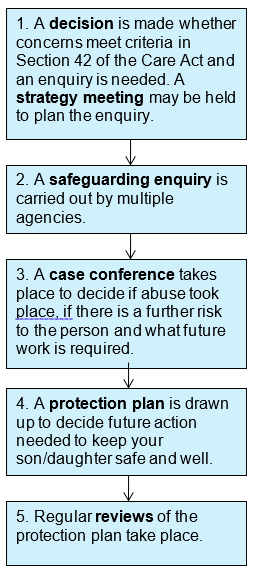
Physical interventions
Read about reactive strategies, restrictive practices and reducing the use of those restrictive practices. Read the 'quick read' summary or download the information sheet.

This information page answers four questions about what to do if you are worried about the safety of someone with a learning disability, and who you should tell. It also describes what happens when child and adult protection referrals are made.
Children and adults with learning disabilities who display challenging behaviour are sadly vulnerable from the risks of hurting themselves or being harmed by the actions of others.
It can be difficult to encounter safeguarding concerns and confusing about what to do. Whatever your involvement in that person’s life, you can take action to help keep them safe and this information gives you an idea of what you can do.
Some problems with a person’s care may be best dealt with by the service itself or a by social worker, for example issues with personal hygiene or access to activities. Other more serious or more urgent concerns are considered safeguarding concerns, also referred to as child protection or adult protection (over 18s).
Safeguarding concerns can range from physical, sexual or psychological abuse, to neglect or inappropriate restrictive practices (such as over-use of restraint or medication). Adults with learning disabilities can also be victims of financial abuse and hate crime; see this information from SCIE about adult safeguarding issues. For more information on child protection issues, including how to spot the signs of abuse, see the NSPCC website.
It may be unclear what has happened, especially if the person with a learning disability is non-verbal or finds it hard to communicate, but it is best to follow your instinct if something doesn’t seem right.
To raise your concerns you should:
Raising a safeguarding concern is different from making a complaint. Try to be clear and specific about your concerns and don’t worry about being criticised for wasting time – it is better to report concerns than to keep quiet. We all have a duty to speak out when we feel something is not right.
The Challenging Behaviour Foundation support families with safeguarding concerns. You can contact the Family Support Service on 0300 666 0126 at any point to discuss safeguarding concerns and what you could do about them. If a safeguarding referral has been made we can support you through the process. All CBF staff and volunteers follow a Child Protection Policy and an Adult Safeguarding Policy (available on request), that require us to refer safeguarding concerns that are not already being investigated.
Professionals and paid staff can get confidential advice about child protection concerns from the NSPCC Whistleblowing Advice Line. Information on whistleblowing in adult health and care services is available from Citizens Advice.
The information below explains the safeguarding process once a referral has been made.
The procedure for safeguarding children will differ depending on the area in which you live. However, the steps below are likely to happen during the course of the investigation.
The local authority where your child lives is responsible for taking action. In the local authority, there will be a Child Protection Team within social services, or social workers with a responsibility for child protection.
If you are unsure of which local authority your child lives under, you can check by visiting: www.gov.uk/find-your-local-council. In Northern Ireland, responsibility for safeguarding lies with the Health and Social Services trust, rather than the local authority.
We have produced a flowchart which shows the typical process local authorities might follow once a referral has been made to their Child Protection Team.
View or download the flowchart
Concerns about a child can be reported to the Child Protection Team, the police or the NSPCC. These three organisations have statutory child protection, powers meaning that they can take immediate action to keep your child safe. Immediate action might include removing your child from the dangerous situation they are in.
If your child is not in any immediate danger, the local authority’s Child Protection Team must decide on the next course of action within 1 working day. They must decide whether:
a) Your child is not at risk of any harm and no further action is needed by the Child Protection Team, or
b) Your child may be at risk of harm and is likely to need additional support or intervention from the local authority or other services.
A social worker should assess your child to find out if they need any additional support or services to keep them safe. This assessment may happen very quickly depending on how urgent your child’s situation is, but may take up to 45 working days. They should discuss with your child their feelings and wishes – if your child has communication problems, they should be given support to do this, or the social worker should try to understand their feelings and wishes in another way. They will also talk to the family and professionals working with your child.
Following this assessment, if the social worker suspects that your child is suffering or likely to suffer significant harm, the local authority should hold a strategy discussion to help it decide if further investigation is needed.
If it is decided that urgent action is needed to safeguard your child, then a strategy discussion between children’s social care, the police and other agencies should take place straight away. At this discussion it must be decided whether immediate safeguarding proceedings are necessary and how these will be carried out. At this discussion it will also be decided how much information will be shared with you and your family.
In some areas there is a group of professionals from the various services called Multi Agency Safeguarding Hub (MASH), who lead the strategy discussion
A section 47 enquiry may take place to decide whether and what type of action is required to safeguard and promote the welfare of a child who is suspected of suffering significant harm. The local authority may want to interview you and your child but should make sure that they do so in a way that minimises distress for you, your child and your family. At the end of the investigation, the local authority will decide if the concerns of significant harm to your child are substantiated (proved) or unsubstantiated (unproven).
If the concerns are unsubstantiated then the social worker will discuss the investigation with you, create a plan detailing the support from other services that might be helpful to your child and help you to get the support your child needs. They may also look at whether your child’s health and development needs to be assessed regularly to make sure they are still safe.
If the concerns are substantiated then the social worker should arrange a Child Protection Conference.
If your child is deemed to be at significant risk of harm, the social work manager should organise a Case Conference involving all agencies who work with you as a family within 15 working days of the strategy discussion. You and your child will probably be invited to attend this unless it is deemed inappropriate by the chair of the conference, who must inform you of this in writing. If this happens you will be able to communicate your views in another way and should be told the outcome of the conference and the complaints procedure. You should also be provided with a copy of the social worker’s report to the conference. It is up to the chairperson whether you will receive a record of the conference.
The conference must decide if a child protection plan needs to be put in place to ensure your child’s future well-being. This will be put in place if your child has suffered significant harm, or if they are judged to be likely to suffer significant harm. The plan should also decide what the outcomes are for your child, what services are needed and who is responsible for what actions. The child protection plan should decide who will be the lead social worker – this should be a qualified social worker with experience. It should also identify the core group of professionals/organisations who must put the plan in place by working together. They must meet within 10 working days of the child protection conference.
A review conference is held within 3 months of the child protection conference to discuss whether your child is still at risk. If they are still at risk, the plan must be revised and a new review held. It is quite common for a child to be deemed ‘still at risk’ at the first review.
If at any point during the safeguarding process it is deemed that there is no longer a significant risk to your child, the safeguarding process can be stopped and children’s social services must decide what future service provision is needed for your child and your family.
Links to further information:
Child protection system in the UK – NSPCC
Working together to safeguard children – UK Government (gov.uk)
Safeguarding children at risk of abuse or neglect – Welsh Government (gov.wales)
National Guidance for Child Protection in Scotland – Scottish Government (gov.scot)
Every area will have a slightly different process for dealing with safeguarding concerns (detailed in local authority safeguarding adults procedures); the following gives a guideline of the process that is likely to occur.
After a safeguarding referral has been made to the safeguarding team, a decision over how to proceed should be made as soon as possible. The safeguarding manager must decide how urgent the case is. If your son/daughter has the mental capacity to speak for themself in this situation, then they will be asked their consent to investigate the claims. If they are assessed as lacking capacity for this situation, then a decision should be made in their best interests (although it would be very rare for a safeguarding enquiry to not be in the person’s best interests).
The safeguarding team lead the process, but other organisations may be involved, such as a Clinical Commissioning Group, NHS Trust the Police or the Care Quality Commission.
The following diagram and information explains the adult safeguarding process:

The safeguarding team must first gather information about the concerns and assess whether they meet the criteria in Section 42 of the Care Act. The safeguarding manager must decide whether further action is required to keep your son/daughter safe and a safeguarding enquiry is needed. All professionals involved should share information they have and discuss how to establish what happened or what risks there are; this may be called a strategy meeting. If the person is at risk of further harm then urgent action should be taken to ensure they are safe.
If a safeguarding enquiry takes place, clear outcomes should be planned, including:
A trained professional will carry out a detailed safeguarding assessment – including talking to people who know your son/daughter and, if possible, communicating with your son/daughter. If you or anyone else are not able to support your relative in the process, then the local authority must give them an independent advocate. There may be stages in an enquiry when staff cannot discuss what is going on with you. Data protection and confidentiality issues may prevent information from being shared with you. Sharing evidence may jeopardise the case going to court in future.
Once the enquiry is completed it should be presented at a safeguarding adult’s case conference. You may be invited to attend this or be updated afterwards and given the minutes of the meeting. Different agencies and professionals involved with your son or daughter should attend and share information about your son/daughter’s safety, welfare and quality of life. The case conference must decide if abuse has taken place and if there is a risk to your son/daughter in future. The conference must also decide on future actions that may need to be carried out to protect your son/daughter and if further a protection plan is needed.
Actions should be planned to keep the person safe in the future, whatever decision was made about the safeguarding concern. If it is decided that your son/daughter is still at risk, then a protection plan should be drawn up for them. Under best practice this should be led by a lead worker and backed up by a core group of professionals from different agencies working together. The protection plan should decide what actions are needed for the future safety of your son/daughter, including what support services will be put in place to help this be achieved. The actions in the protection plan should be added into their care plan.
After the protection plan has been put in place, a review of the plan needs to take place regularly to check that it has met the outcomes. The review should decide whether your son/daughter is still at risk and if the plan needs adjusting.
Care and Support Statutory Guidance, Chapter 14, Safeguarding – Gov.uk

Read about reactive strategies, restrictive practices and reducing the use of those restrictive practices. Read the 'quick read' summary or download the information sheet.

The Family Support Service can provide information and support about the needs of your family member with a severe learning disability. Our support is confidential, and we won’t judge you or tell you what to do.

This page provides useful information if you are you unhappy with the care of your relative, including how to raise a concern and what to do if you are not happy with the outcome of the complaint.